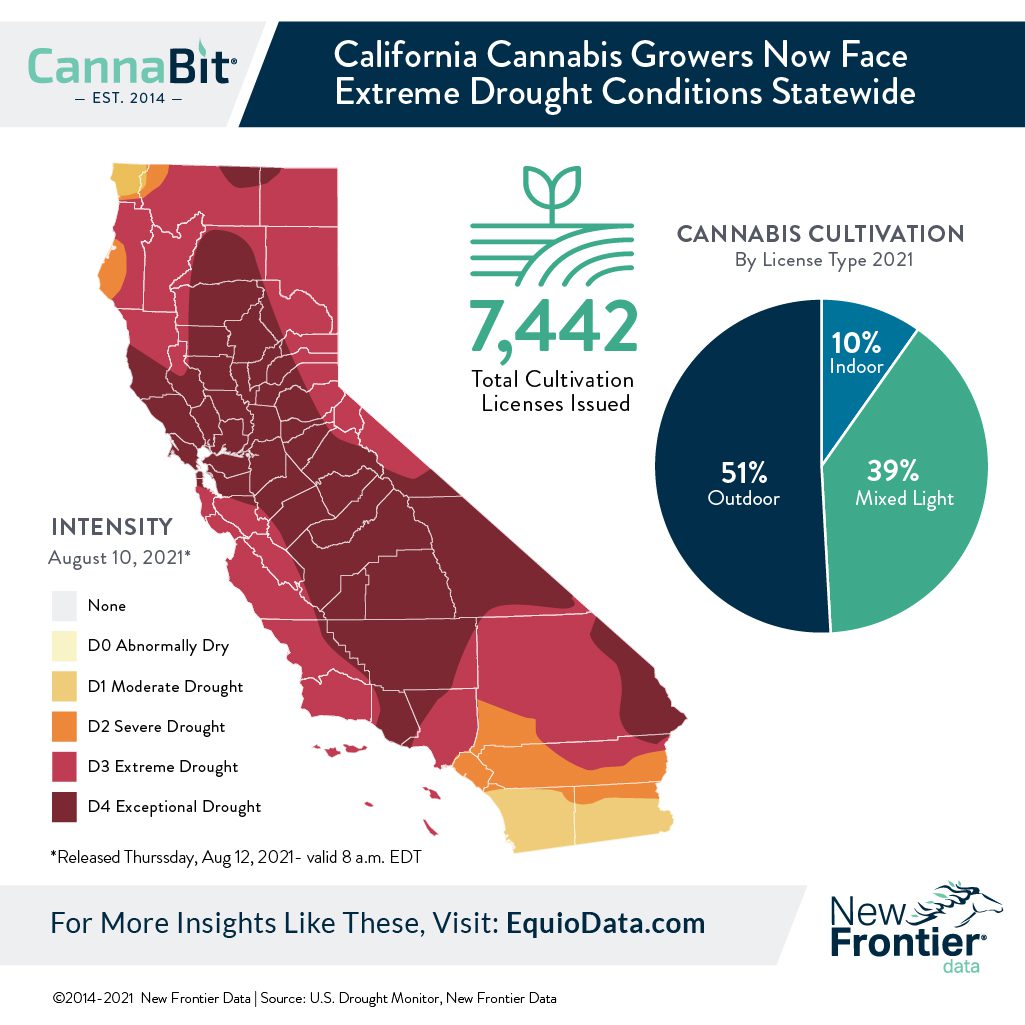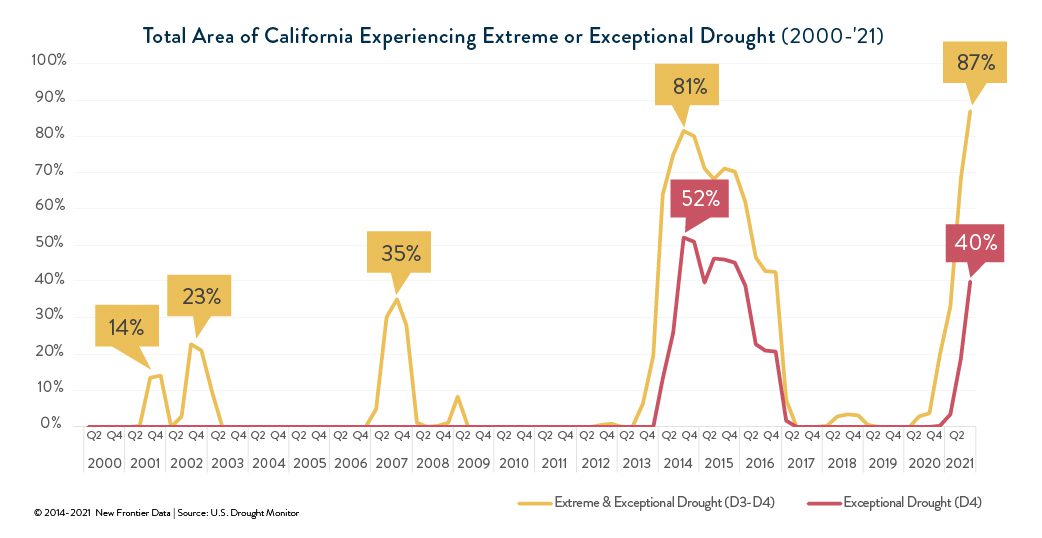Facing Extreme Weather and a Changing Climate, Cannabis Producers Must Adapt.


By John Kagia, Chief Knowledge Officer, New Frontier Data
Now over a month old, California’s catastrophic Dixie Fire has scorched more than half a million acres, making it the second-largest wildfire in the Golden State’s history. With less than a third (31%) of it reportedly contained, and critical burn conditions forecast, it is expected to cause significantly more destruction before it is contained. More worryingly for stakeholders in the state, the Dixie Fire is but one among more than a dozen fires of interest being tracked by Cal Fire, the state’s firefighting agency.
Unseasonably high temperatures, record droughts, and untamed wildfires characterize a particularly grim future facing western U.S. states, and California stands exceptionally vulnerable. According to the U.S. Drought Monitor, 88% of the state is facing extreme or exceptional drought conditions – the most extensive drought conditions registered since 2000, with essentially half (47%) of the state subjected to extreme drought conditions.
The effects are acute: As detailed by the U.S. Drought Monitor, exceptional drought produces costly fire seasons, meaning that “the number of fires and area burned are extensive”.
Water availability and quality also deteriorate as water shortages become widespread, surface water is depleted, federal irrigation water deliveries are extremely reduced, junior water rights are curtailed, water prices become extremely high, wells turn dry, more and deeper wells get drilled, and overall water quality is poor.
While California has experienced seasonal droughts every few years throughout the past two decades, this season’s drought is shattering long-standing records, subsequently straining the state’s water resources in unprecedented ways.


Though water shortages and quality issues stemming from drought will impact all growers, more frequent and intense fires seasons are of particular concern to California’s outdoor growers, who to date account for half of the state’s issued cultivation licenses. Not only are disproportionately large numbers of outdoor growers located in the increasingly fire-prone Emerald Triangle (i.e., Humboldt, Mendocino, and Trinity counties), but even those who have less direct exposure to wildfires must contend with the impacts of smoke and ash on their cannabis flowers.
Exposure to smoke and ash prove especially pernicious for outdoor cultivators, since they not only alter the flavor of the cannabis, but (depending on both the type of fire and properties involved) may contain toxic chemicals which threaten to doom a crop’s passing its state-mandated testing.
For any grower among a region most at risk, integrating climate-change mediation tactics into one’s strategic planning is increasingly a business imperative.
- In the face of more costly/less available water, growers must gear up operations to optimize water efficiency, both to lower production costs and to minimize risks from water shortages. Included in New Frontier Data’s recent report, Cannabis H20: Water Use & Sustainability in Cultivation, are detailed methods which growers may adopt to reduce water use, minimize waste through reuse and reclamation, and leverage newly emerging technologies to help drive even greater efficiency for cultivation.
- As summer temperatures creep higher, and for longer periods, indoor and greenhouse growers must not only ensure that their HVAC and climate-management solutions are able to cope with higher demands, but they must also budget for the requisite higher energy costs to maintain optimal temperatures and humidity within the grow environment. As such, investing in energy-efficient solutions now (even as they may command a premium cost) may nevertheless yield long-term savings as the demands on the system compound over time.
- As droughts become more persistent, breeders should prioritize drought-resistance techniques in their crossbreeding programs. Producing hardier, heat-resistant, and less thirsty genetics will not only benefit outdoor growers (largely unprotected from the most extreme weather), but any growers who seek to reduce the water-use, humidity, and cooling requirements in their facilities.
The latest analysis by the Intergovernmental Panel on Climate Change paints a grim picture of the planet’s overall outlook as the climate changes, and serves as immediate call to action for governments, businesses, and societies to work collaboratively to reduce the impacts of human enterprise on the planet. Unfortunately, given the critical realities which current extreme weather conditions illustrate, what is now being experienced will likely turn ever more severe. Thus, cannabis industry stakeholders — especially those in the highly productive Western states — must begin preparing in greater earnest for how to grow cannabis (beyond operating any business) in an environment made inescapably hotter, drier, and more unpredictable.


